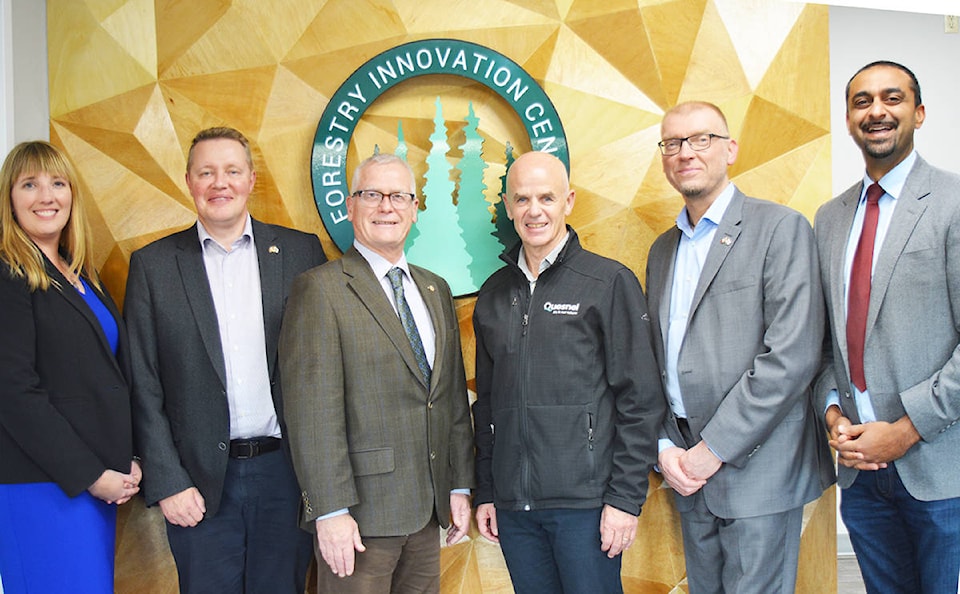Jim Hilton
Observer Contributor
Quesnel has been making the news lately about taking seriously the need to diversify and develop business to compliment the dimension lumber and pulp industry, which has been a major employer in the city.
In 2018, the city council, led by Mayor Bob Simpson, promoted the idea of the Forest Innovation Centre.
The $160,000 centre, located on the second floor of City Hall, was officially opened in the fall of 2019, at which time staff involved with the centre were introduced. Forestry Initiatives Manager Erin Robinson and Forestry Initiatives Co-ordinator Lacy Scuff will be responsible for the operation of the new facility.
While it includes offices and research space, the centre also showcases different wood products from the local area, as well as some new innovative ideas about the future of forestry.
As described on the City’s home page, the centre will encourage experimenting with wood-fibre residues and other by-products of forest product manufacturing. Some of these products include prefabricated construction materials, wood composites, biochemical, nanotechnologies, and biodegradable single-use products. Simpson noted that these products could soon been in high demand. The Province requires that engineered wood be used wherever possible for public infrastructure projects, including the new Royal BC Museum in Victoria and the new St. Paul’s Hospital in Vancouver. And there is currently a global shift away from single-use plastic items like straws and bags, as well as “fast fashion” made from non-polluting fabric production.
Clothing and fabrics made from wood products are becoming more common. My daughter recently returned from Vancouver with a shirt made from certified renewable wood sources, and Amazon has a wide variety of household fabrics also made from wood.
The latest edition of the Logging and Sawmilling Journal (LSJ), February 2020, describes a number of innovations that could be added to the ones described above. Alberta Innovates has been working with Cellulose Nanocrystals CNC to make nanogel, which resists removal by saliva, thereby enabling better treatment with drugs for oral cancer.
The Forestry Initiatives Program (FIP) was created in Quesnel to address the multiple challenges facing the community in the forests adjacent to the city.
This includes protecting the municipality, and the smaller communities surrounding Quesnel, from wildfire by encouraging home and business owners to FireSmart their properties as part of the Community Wildfire Protection Plan (CWPP). The FIP is working with the Province on a landscape-level analysis and restoration project, along with exploring ways to innovate the forest products manufacturing sector. A number of options are anticipated, including the use of prescribed fires, forest management methods like pre-commercial and commercial thinning and utilizing more fibre, including the volumes left after the conventional harvesting of insect and fire damaged timber.
These kind of activities often create logging debris, which has often been burned on site, that could go into making a number of high-value products such as nanocrystalline cellulose, biochemical replacements for petrochemical use, or paper alternatives for single-use throw-away items, as described above.
One item which was not mentioned is the production of biochar from logging debris. Also described in the LSJ, there is a new biochar maker being marketed by Tigercat. As described in their brochure, the 6050 Carbonator is an advanced, cost-effective and environmentally-friendly wood debris conversion system. The 6050 accepts logs, limbs, brush, stumps, yard waste, pallets, clean lumber and other clean wood-based material. It has a high throughput rate, with no material pre-processing required, along with a large blower to recirculate air for re-combustion.
I would like to thank Erin Robinson for her comments, as well as the following paragraph.
“The province of B.C. is facing significant challenges, including: milder winters, increased insect occurrence (and other forest pathogens), longer and more intense wildfire seasons, and dramatically increased flooding events. Large-scale disturbances have put pressure on traditional forestry methods and are forcing industry and land managers to reconsider how forest ecosystems are managed. It’s important we have a road-map for moving from traditional forestry to new and innovative methods, and the City of Quesnel’s FIP, along with project partners, is creating a plan for their community that can be rolled up to the regional and provincial levels. Learning from Quesnel’s FIP, over time, will provide guidance on how forest product manufacturing processes can be innovated to respond to the types of fibre B.C.’s central interior forests provide now and into the future.”
Jim Hilton is a professional agrologist and forester who has lived and worked in the Cariboo-Chilcotin for the past 40 years. Now retired, he volunteers his skills with community forests organizations.
READ MORE: City of Quesnel celebrates grand opening of Forestry Innovation Centre
editor@quesnelobserver.com
Like us on Facebook and follow us on Twitter
